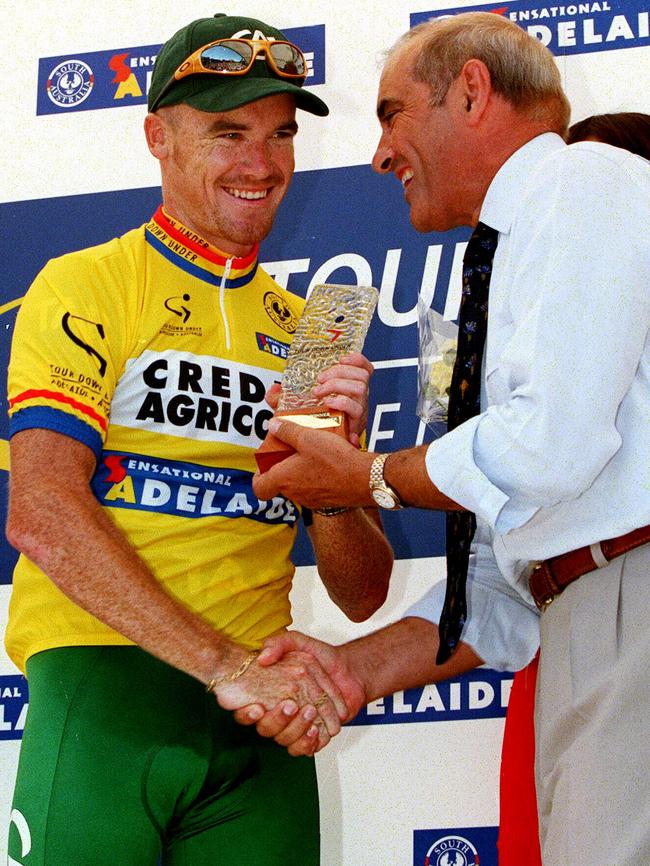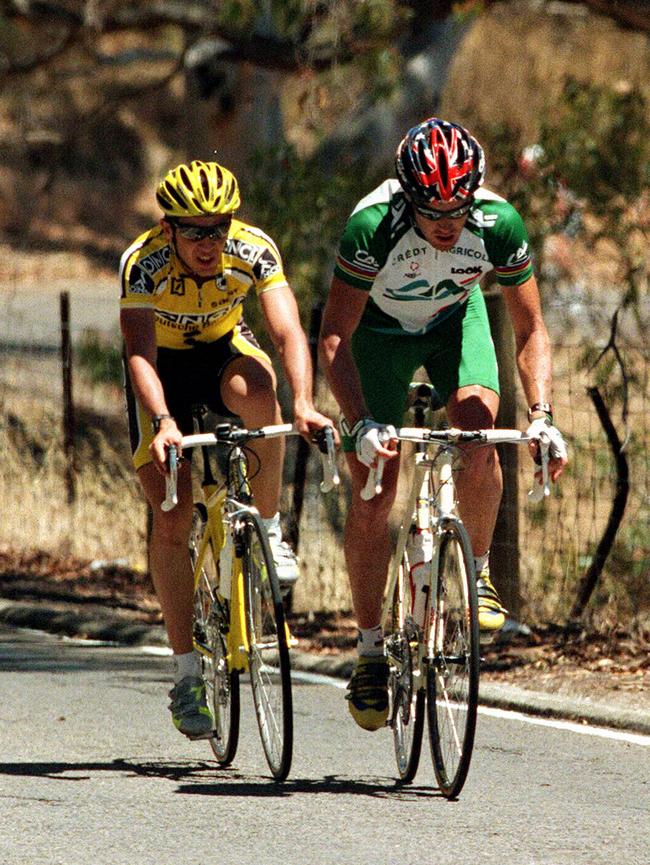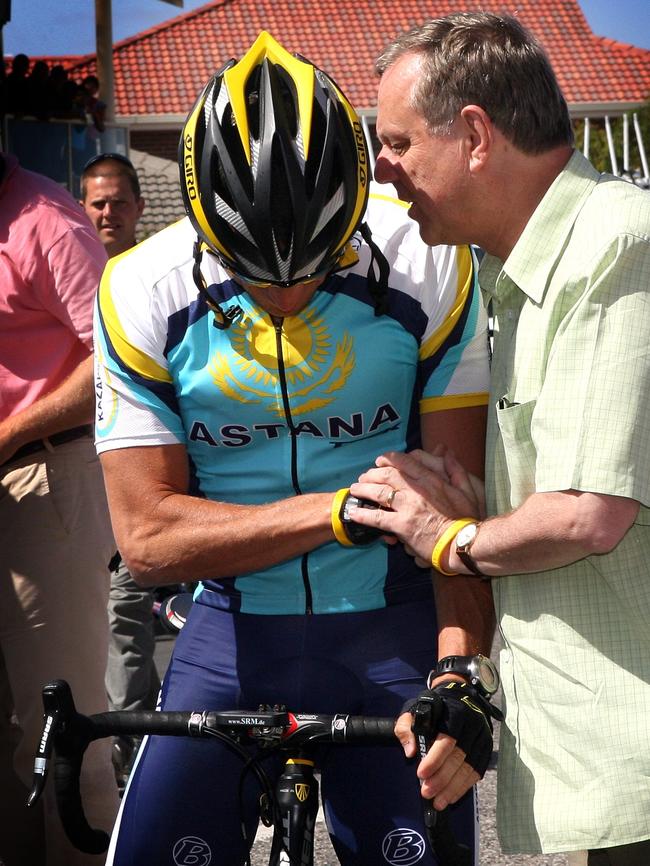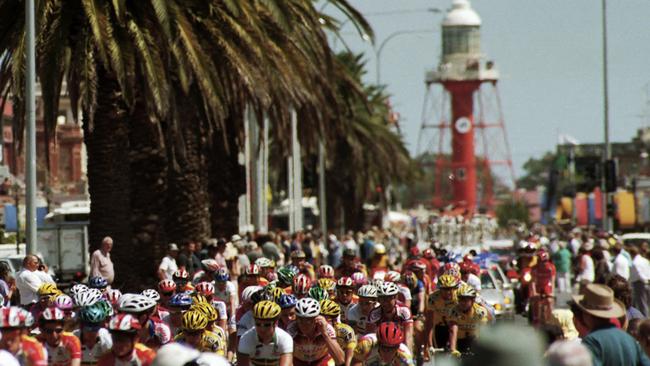Tour Down Under history: A risk on a race that put SA on map
TWENTY years ago, the State Government took a $1.8 million punt on a cycling race to help re-energise SA’s international reputation. The Tour Down Under has since become our biggest single event.
City
Don't miss out on the headlines from City. Followed categories will be added to My News.
- Lance Armstrong: ‘I would not change a thing’
- TDU cyclists warned to follow road rules
- TDU 2018 returns to the Port
HOURS before the first stage of the 1999 Tour Down Under, then-Premier John Olsen left his North Tce office bound for the East End.
Olsen was anxious.
He had plenty riding on this new event striking a chord with South Australians and the peloton of professional cyclists who had travelled halfway around the world to compete in it.
Would it be a success, Olsen wondered, or had his government just blown $1.8 million bankrolling a “dud”?
“As we drove down North Tce, I remember sitting in the car and saying ‘When we turn that corner, there better be people’,” Olsen said this week.
“When we did, there was this massive, massive crowd.
“This wave of relief came over, the anxiety just drained away.”
An estimated 40,000 spectators had packed Rundle St for the opening night street race, far exceeding even the most optimistic pre-race predictions.
Amid the masses, Olsen sought out Mike Turtur, the race’s director.
“We looked at each other,” Turtur said.
“And we just knew something was happening here, that we had struck a nerve.”


On the eve of the 20th Tour Down Under, The City looked back at the history of what is now the largest cycling race in the southern hemisphere, speaking with the people who brought the event to Adelaide, as well as the now-disgraced figure whose mere presence changed it forever.
Established in part to rebuild the state’s international reputation following the loss of the Grand Prix, the TDU now helps define it.
The race — which is beamed into millions of households worldwide — is a rolling postcard of SA’s picturesque landmarks, from McLaren Vale and Port Willunga to Stirling and the CBD.
Almost 840,000 spectators caught a glimpse of last year’s race, and tens of thousands more attended pre and post-stage street parties, pumping more than $56 million into the state’s coffers.
The idea of a multi-stage cycling race to showcase SA as tourist destination came from Turtur, a 1984 Olympic gold medallist and former manager and promoter of the Adelaide Superdrome.
He was encouraged to pitch the concept after talks with the head of Australian Major Events, the body tasked with attracting events to fill the chasm after the Formula One cars left town in 1995.
Olsen, desperate to find ways to lift what he described as a “pall of despondency that had settled on South Australia”, was initially sceptical about the pulling power of a cycling race.
“I remember at the time saying, ‘Tell me, who goes to a bike race?’,” he told The City.
“We discussed it and thought, would we gamble $1.8 million on this? Because we did not have the luxury of cash, like Victoria.
“But we had to chance our arm … if you don’t do it because you are nervous of failure then you will never do anything.”
The inaugural race was booked for January 1999. Turtur was charged with mapping out a race route and assembling a field.
Well-connected in international cycling circles, he convinced some of the world’s best riders to venture Down Under, including French superstar Laurent Jalabert, to race against Australians Stuart O’Grady, Baden Cooke and Cadel Evans.
It was a major coup — provided Turtur could ensure the big names actually made it to the start line.
“We have a pre-race heatwave and (star German sprinter) Eric Zabel threatened to go home,” Turtur said.
“I begged him to stay and took him out to dinner, pleaded with him and said it would be good for his physiology and that all that bull****.
“I knew that if he went home, it would make our job a lot harder.
“He agreed to stay and won two stages, had a great season and came back the following year.”
The inaugural race, won by O’Grady, was widely hailed as a success, with Olsen announcing soon after that it would become a fixture on Adelaide’s event calender.

It grew in popularity and prestige over the following decade and, in 2008, become the first race outside Europe to secure World Tour status, guaranteeing the continued presence of cycling’s elite.
And then there was Lance.
In September 2008, the State Government announced Lance Armstrong, the cancer-conquering, seven-time Tour de France-winning American, would use the 2009 TDU to kickstart a comeback to professional cycling.
His three race appearances — secured with an infamously secretive government payment — transformed the event, triggering a massive spike in visitor numbers and international media interest.
But Armstrong’s life ban from cycling in 2012 for using performance-enhancing drugs left an awkward, and indelible, stain on those successes.

The Texan said in interviews in 2015 that his decision to return to cycling ranked among his biggest regrets, given it led to his spectacular fall from grace.
But Armstrong has since changed his tune.
“If you had asked me three years ago, I would have said ‘absolutely’, but where I sit today, five years post, I wouldn’t change a thing,” Armstrong told The City.
Armstrong said the TDU was, and is, “without a doubt” one of the best cycling races outside Europe.
He this week recalled Adelaide’s hot summer days — incomparable, even, with Texas’s “insanely hot” weather — as well as memories of Hutt St restaurant Chianti and Penfolds winery.
Asked to judge his overall contribution to the race, with all things considered, Armstrong was unequivocal.
“100 per cent positive,” he said.
Turtur, a self-described “believer” in Armstrong’s too-good-to-be-true tale, was effusive about the American’s “phenomenal” imprint on the race.
“His presence, the returned benefits to the race and to this state and to awareness around cancer … money cannot buy,” he said.
“The smallest increase that we saw was 100 per cent, it was staggering, and we are still benefiting from that legacy.”
Turtur said the expected slump after Armstrong’s final appearance in 2011 never eventuated, with subsequent races reporting “10-15 per cent increases” across the most important metrics.
The race has continued to attract some of the world’s best riders, including three-time World Champion Peter Sagan and Tour de France winners Alberto Contador, Andy Schleck and Oscar Pereiro.

Off the track, the event’s “tentacles”, as Olsen described them, extend further than ever, with the Tour Village in Victoria Square, BUPA Challenge amateur ride and numerous street parties attracting hundreds of thousands of people.
Tourism Minister Leon Bignell said the TDU had become the largest event in SA.
“The race benefits the state in so many ways, obviously in terms of the money and the jobs generated through visitation to Adelaide and our regions,” he told The City.
“But the other big benefit is the enormous pride South Australians feel about hosting the world’s biggest cycling race outside of Europe.”


